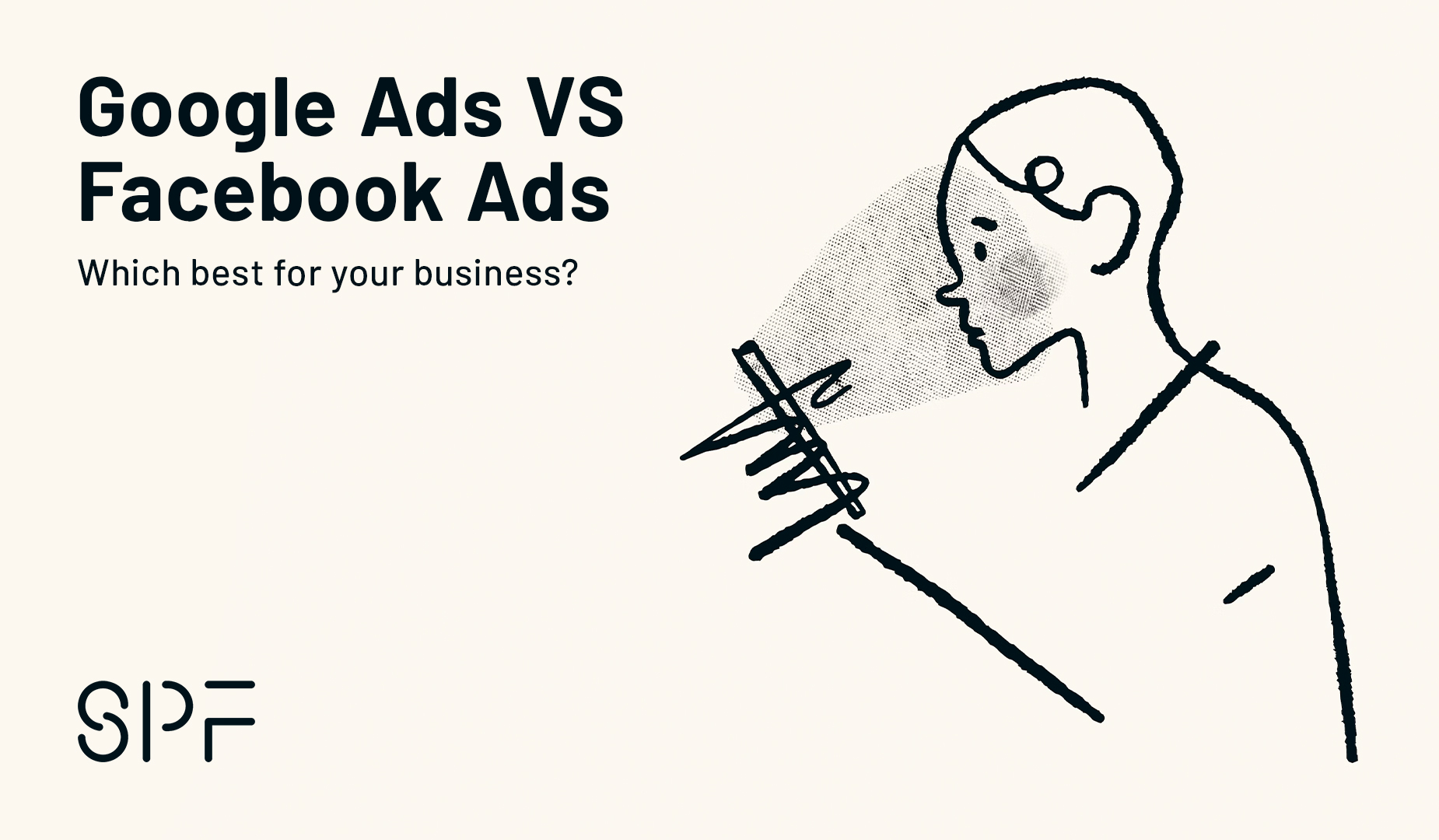
Google Ads VS Facebook Ads - Which is better for small businesses?
Organic growth and word of mouth can turn an idea into a small business. However, paid advertising can be key for scaling up. Companies have no shortage of online advertising platforms to choose from, but knowing where to invest your hard won profits can be a stab in the dark for a lot of business owners. SPF are here to help small business owners turn on the light.
Let's start at the beginning - What are Google Ads?
Google Ads (formerly Google AdWords) are targeted pay-per-click (PPC) advertisements, so you only pay when someone clicks on your ad - small business typically set a daily budget; the more you spend the higher the return. These ads appear on Google searches, the Google Display Network (a group of more than two million websites) and Google properties such as Gmail and YouTube.
The most popular Google Ad type is the Paid Search Ad which run text-only on a search engine results page (SERP) based on both relevancy to search words and how much the advertiser paid for those keywords. Other popular ad formats include Google display ads, which are image-based banner ads that appear throughout the Google Display Network, and Google shopping ads, which display a particular product in Google Search results.
Google advertising is targeted, meaning advertisers can focus on their target audience based on search intent by using certain keywords and phrases, and demographic information such as age, gender, location, family status, and household income.
What are the advantages of Google Ads?
Google Ads offers a variety of targeting options and ad formats, each with their own unique benefits, but its two greatest strengths are:
- Extensive reach. No matter your target audience, you will likely reach them with Google Ads. Google processes more than 40,000 search queries every second, making up 92% of all search network activity and showing search ads at the top of results. And Google display ads run on the Google Display Network, which reaches more than 90% of the world’s internet users—increasing the chances of a casual browser becoming a potential customer.
- Attracting a high purchase intent audience. Google Ads match advertisers to people who search for keywords that are relevant to your business. So, those who click on Google search ads often do so with the intention to learn more or even buy a product. (This is called having a high “purchase intent.”) For example, imagine winter is approaching, and you find your kid has outgrown last year’s puffer coat. You might Google “winter coats for kids,” click on a Google Ad, and make a purchase on the spot.
What are Facebook Ads
Facebook Ads are targeted social ads that appear across Meta properties including Facebook, Instagram, and Facebook Messenger. These ads can include images, carousels (a series of swipeable images), and videos that appear in main feeds, Stories, or Reels on Facebook and Instagram.
How do they work?
Facebook ads show up in social media users’ feeds as they browse Meta apps, including Facebook and Instagram. The ads appear much like regular posts, but have the word “Sponsored” below the profile name when advertisers pay to appear in your feed. Facebook advertising offers advanced targeting options so advertisers can find their target audience based on both demographics—age, gender, location, family status, and household income—and user interests and behavior, including friends, pages interacting with, and other clicked ads.
Facebook Ads offers both PPC campaigns and pay-per-impression (PPM) campaigns, where advertisers are charged per 1,000 impressions.
The advantages of using Facebook Ads
With nearly three billion monthly active users, Facebook is the most trafficked social media platform. This gives Facebook Ads a vast audience and competitive edge over Google Ads in two areas:
- Advanced targeting options. Facebook allows advertisers to reach their target audience with a precision not available to other advertising platforms. Their advanced targeting options go beyond (but are inclusive of) standard demographic information like gender, age, location, family status, political leanings, and income. You can target potential customers based on life events like a new job or pet, as well as interests, who they follow, and buyer profiles.
- Brand building with memorable ads. The ability to create unique and visually appealing ads is an area where Facebook Ads outperforms Google. As a platform geared toward sharing eye-catching multimedia posts and created with mobile optimization in mind, Facebook offers its users opportunity for vast creativity. Businesses can use a variety of images and videos to create memorable ads that build their brand and meet customers where they are: on social media.
Google Ads vs. Facebook Ads: similarities and differences
Which online advertising platform is better for your business’s needs? While they offer some similar benefits, you must consider the distinctions when deciding how to spend your ad budget. Here’s how Google Ads and Facebook Ads compare:
Reach
- How they’re similar: Google and Facebook are dominant in their respective fields (search engines for Google and social media for Facebook).
- How they’re different: Google’s reach is unparalleled—it is the most visited website in the world. While Facebook has three billion monthly users, Google is on a different scale, with nearly three billion searches per minute.
Targeting Options
- How they’re similar: Both Google Ads and Facebook Ads offer demographic targeting.
- How they’re different: While Google leans more on keywords to find an audience for ads, Facebook is able to use its user data to pinpoint a business’s ideal customer.
Ad Formats
- How they’re similar: Both ad platforms offer multiple ad formats.
- How they’re different: Google Ads’ most popular ad, the Google search ad, is text-only. Google display ads include an image, but offer less options for creativity. Facebook Ads, however, offer greater flexibility. They are typically more visually driven and include images, videos, and carousels.
So when should you use each platform?
Choosing between Facebook Ads and Google Ads will come down to your company’s audience, industry, and business goals. Typically, Google Ads are better for making sales, while Facebook Ads are better for building brand awareness and connecting with customers.
For example, if your company sells a utilitarian product like heat pumps you might prioritize making sales to new customers who need your product over building a loyal following. So, you’d probably choose Google Ads. By comparison, if you run a trendy fashion company that values its cool factor, you might invest more into strengthening your brand and connecting with your audience to convince them your pieces are worth having. In this case, Facebook Ads might be the better choice. While these types of ads may not result in immediate conversions, you could cultivate a loyal customer base over time.
SPF are not only experts in digital marketing we pride ourselves in really getting to know your brand/company so that we can design the best ditigal marketing startegy for you. We don't believe in a one size fits all system and you can rest assured that we go above and beyond getting out clients the most out of their budgets. If you would like to speak to one of our sales and marketing team then click the button below.
